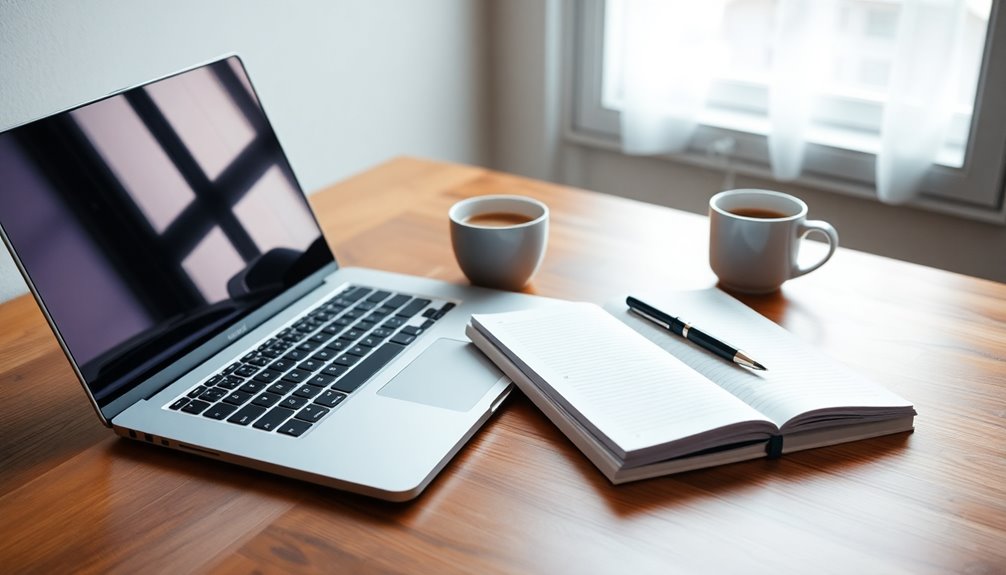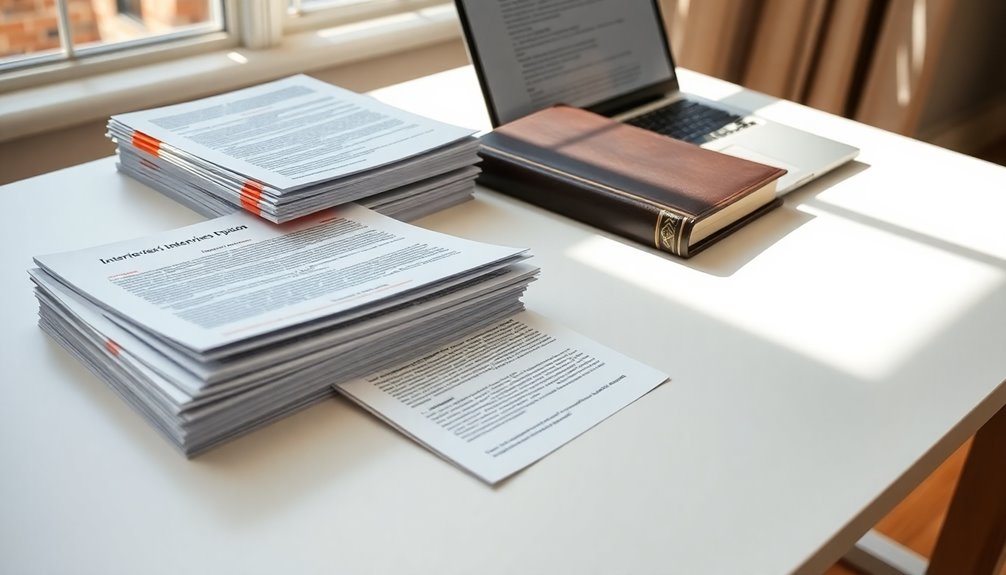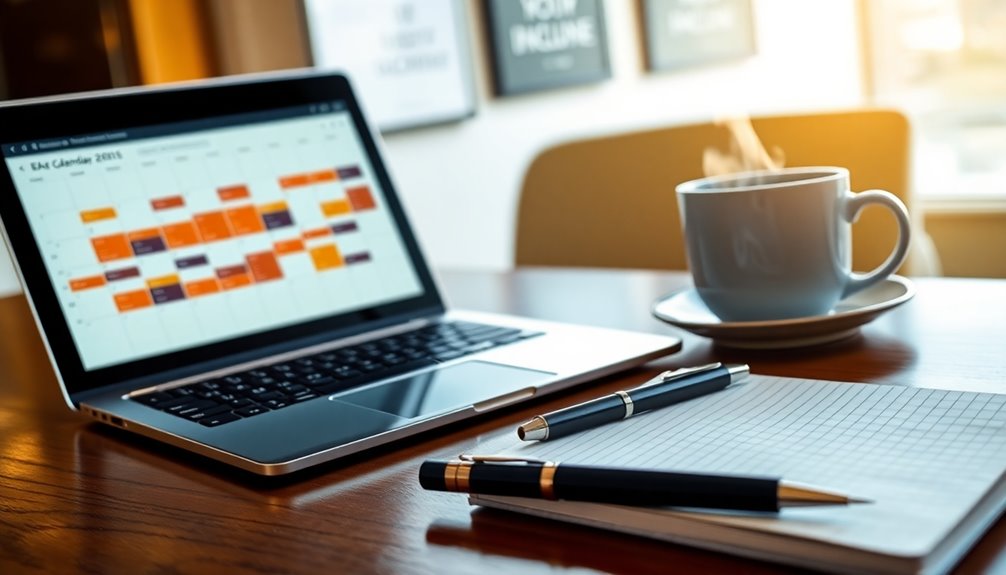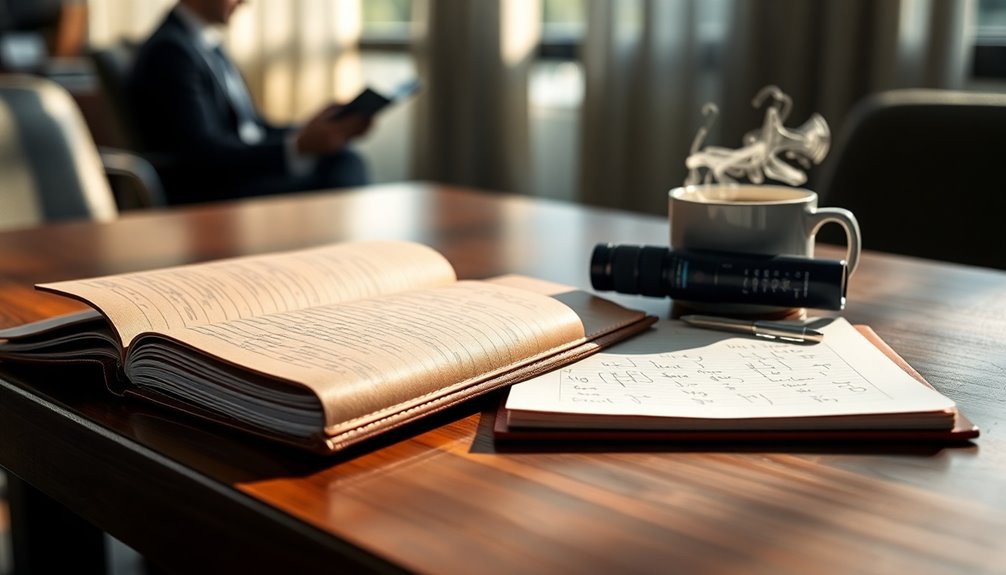To craft the perfect email response that showcases your professionalism, start with a clear subject line that grabs attention. Use a polite greeting and maintain a professional tone throughout. Keep your message concise, organizing content into short paragraphs or bullet points for easy reading. Acknowledge receipt of emails promptly to enhance communication flow. Include a clear call to action, motivating timely responses. Finally, polish your email signature with your name, title, and contact info. Avoid common pitfalls like vague subjects or lengthy messages. Master these tips, and you'll be well on your way to impressing your recipients and fostering better relationships.
Key Takeaways
- Start with a clear purpose statement to capture attention and set the direction of your email.
- Use a professional tone with proper grammar, spelling, and personalized greetings to reflect respect and professionalism.
- Acknowledge receipt of the email promptly within 24 to 48 hours to maintain communication flow and show attentiveness.
- Include a specific and actionable call to action (CTA) at the end to guide the recipient's next steps effectively.
- Craft a polished email signature with your full name, title, company, and contact information for easy identification and credibility.
Importance of Subject Lines
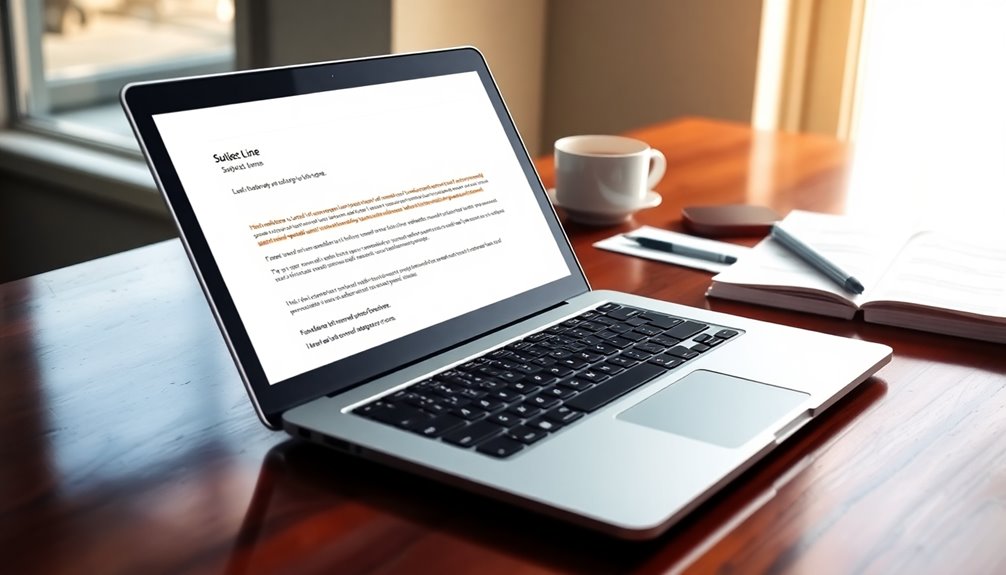
When you hit "send" on an email, the subject line is your first chance to grab attention. It's vital for clear communication and can greatly impact open rates and response times. Engaging subject lines like "Invoice #1234 – Payment Inquiry" instantly inform the recipient about the email's content, making them more likely to open it. In contrast, vague subject lines such as "Payment Info" can lead to confusion and lower engagement.
To improve your email effectiveness, consider A/B testing different subject lines. This way, you can identify which formats resonate best with your audience. Remember, clarity in your subject lines helps recipients prioritize their emails and guarantees important messages aren't overlooked.
This is especially important with technical inquiries, where precise subject lines provide immediate context. When you're clear about the email's purpose, it facilitates quicker responses from recipients. So, make it a habit to craft engaging and specific subject lines. They're not just a formality; they're your gateway to effective communication and stronger relationships. By prioritizing your subject lines, you'll enhance clarity and minimize confusion, leading to better outcomes in your email exchanges.
Professional Tone and Etiquette
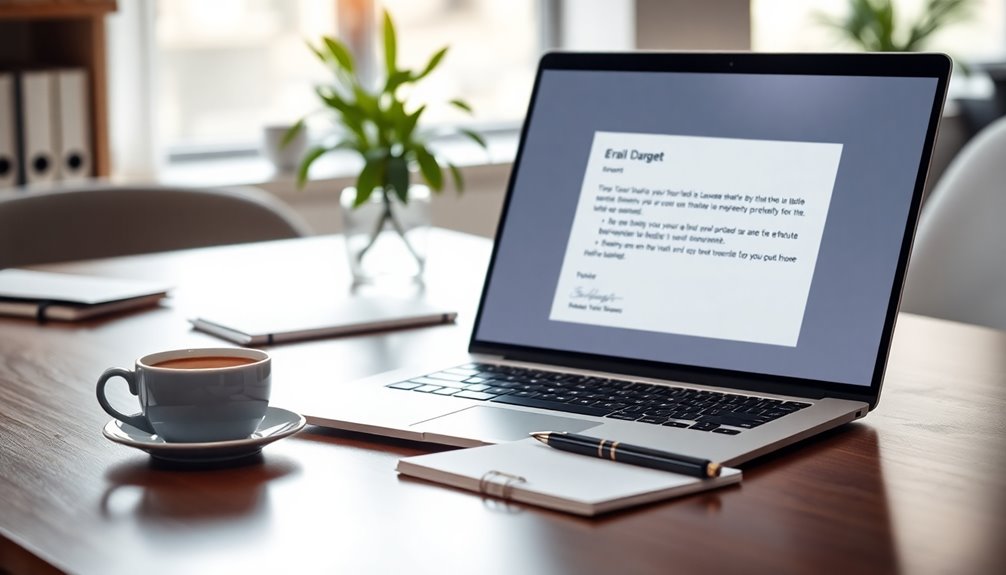
A polished email reflects your professionalism and respect for the recipient. To achieve this, you must adopt a professional tone that aligns with email etiquette. Start with a polite greeting, like "Dear [Name]," to establish a positive first impression. This simple step sets the stage for respectful communication.
Clear communication is crucial. Verify your message is concise, using proper grammar and spelling to maintain professionalism. Mistakes can undermine your credibility and lead to misunderstandings. Tailor your tone based on the recipient and context, especially in formal settings like job applications or external correspondence.
At the end of your email, include a clear call to action. This guides the recipient on the next steps and demonstrates your respect for their time. Responding promptly also reflects your commitment to effective email communication.
Structuring Your Email
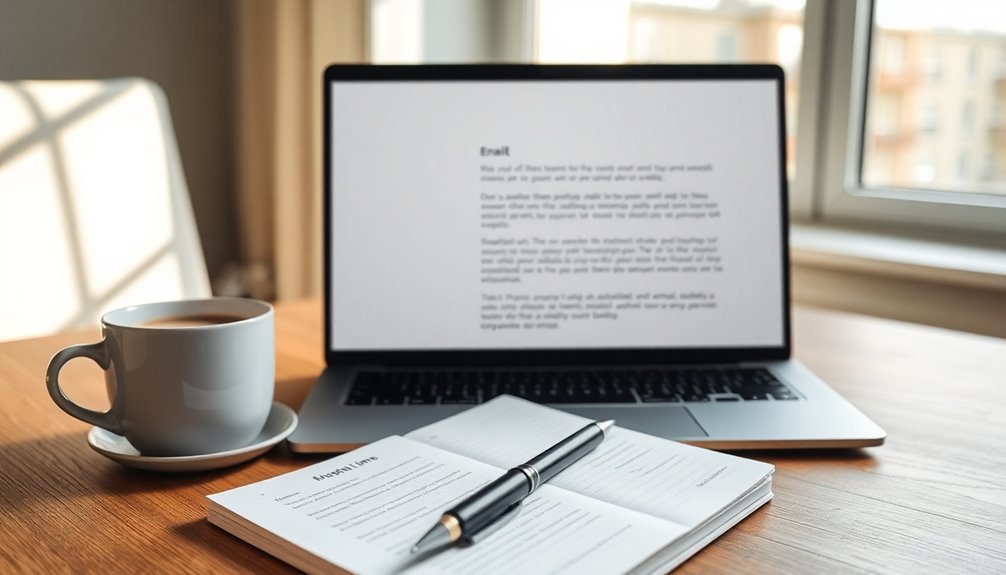
When structuring your email, start with a clear purpose statement to set the tone. Organize your content into concise paragraphs or bullet points for better readability, making it easy for the recipient to grasp key information. Don't forget to include an engaging call to action at the end, encouraging a response or further discussion. Additionally, being aware of cookie management practices can enhance your professionalism by showing attention to detail and concern for privacy.
Clear Purpose Statement
Often, a clear purpose statement at the beginning of your email can set the tone and direction for the entire message. By clearly articulating your intent, you help recipients quickly grasp the main objective, making your communication more effective. This clarity not only enhances your professional communication but also fosters positive relationships.
Here's a simple breakdown of the benefits of a clear purpose statement:
| Benefit | Description |
|---|---|
| Timely Response | Recipients can prioritize important emails more easily. |
| Enhanced Open Rates | Engaging subject lines with a clear purpose boost open rates. |
| Reduced Misunderstandings | Clear and concise purpose statements minimize confusion. |
| Maintained Professionalism | A structured email reflects professionalism and respect. |
Incorporating a specific purpose statement is key to maintaining effective communication. It saves both you and your recipient valuable time, ensuring that important details don't get lost in the shuffle. Additionally, establishing a clear purpose can enhance your overall mental well-being, allowing for smoother interactions in both personal and professional settings. So, when crafting your emails, remember: a well-defined purpose statement is essential for achieving your communication goals.
Organized Content Structure
Structuring your email effectively can make a significant difference in how your message is received. Start with a polite greeting that sets the tone for your professional email responses. Reference the original email or context to maintain engagement. An organized content structure is essential; break your email into clear paragraphs and use bullet points to enhance readability. This approach guarantees that key points are easily digestible.
Keep your sentences concise and focused on the main ideas. Avoid lengthy, convoluted messages that might lose your reader's attention. A logical flow of information helps your email feel coherent, with smooth shifts between paragraphs. This way, your recipient can follow your thoughts without confusion.
Conclude with a polite closing statement that reinforces your professionalism. A clear call to action encourages further engagement, prompting the recipient to respond or take the desired next step. By following these guidelines, you'll create emails that are not only effective but also reflect your professionalism and attention to detail. With organized content structure, you'll guarantee your messages resonate and elicit the responses you seek. Additionally, consider using A/B testing to determine which email formats and content engage your audience best.
Engaging Call to Action
An engaging call to action (CTA) is essential for guiding your recipient towards the next steps you want them to take. A well-crafted CTA not only boosts engagement but also greatly enhances your email's response rate. To achieve clear communication, make your CTA specific and actionable. For instance, using phrases like "Please confirm your availability for a meeting next week" or "Click here to access the document" provides clear direction.
To enhance clarity, guarantee your CTAs stand out visually. Consider using bold text or buttons to draw attention and encourage immediate action. Adding a sense of urgency can also motivate quicker responses. For example, saying "Respond by Friday to secure your spot" can push recipients to act promptly.
Don't forget to test different CTAs in your emails. This practice helps you determine which phrasing resonates best with your audience, leading to higher engagement rates. By optimizing your CTAs, you'll not only improve the effectiveness of your professional email but also guarantee that your recipients clearly understand the next steps they need to take. Remember, an actionable CTA is a key component of effective email communication.
Timeliness and Acknowledgment
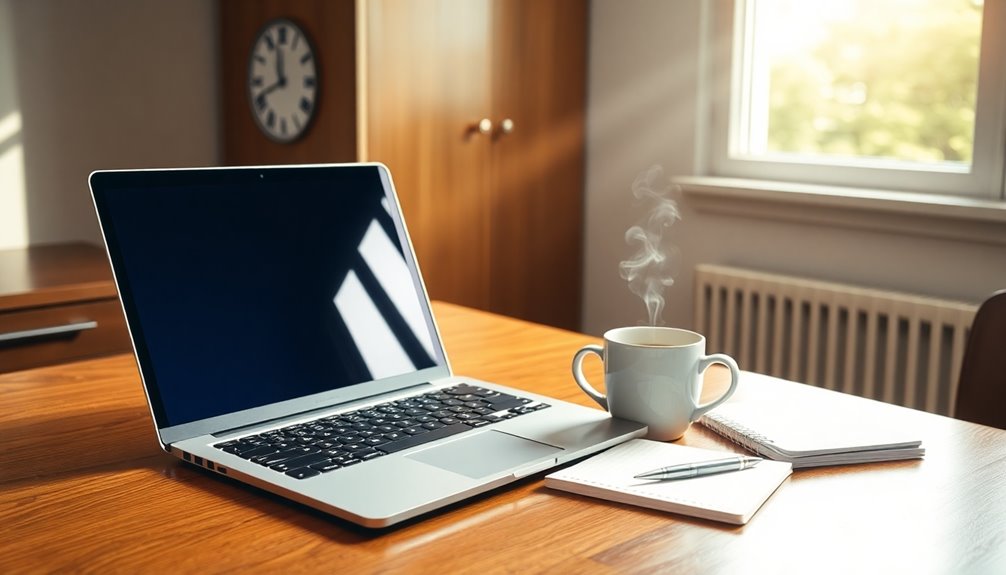
Timeliness in your email responses is key, with a 24 to 48-hour window being ideal for important messages. By acknowledging receipt, even if you can't respond fully right away, you show that you're engaged and attentive. This simple act not only maintains the flow of conversation but also builds trust and professionalism in your communication.
Importance of Prompt Replies
In the fast-paced world of email communication, responding promptly can make all the difference in maintaining professional relationships. When you send prompt replies, you show respect for the recipient's time and enhance your professional reputation. Timely replies help keep the communication flow active, preventing bottlenecks that can derail decision-making processes. Incorporating practices such as self-care and mindfulness can also help you maintain mental clarity, allowing for more effective communication.
| Action | Impact | Outcome |
|---|---|---|
| Respond within 24-48 hours | Demonstrates respect | Strengthens relationships |
| Acknowledge receipt | Keeps communication flowing | Builds trust and reliability |
| Provide clear communication | Prevents misunderstandings | Enhances customer satisfaction |
| Maintain consistency | Fosters loyalty | Benefits business outcomes |
Studies show that your email response speed can directly influence customer satisfaction and loyalty. By acknowledging receipt, even if a full response takes longer, you convey attentiveness. This simple act can greatly enhance professional relationships, making others feel valued. So, prioritize timely replies in your email strategy, and watch how it transforms your interactions!
Acknowledging Receipt Effectively
Acknowledging receipt of an email is a vital part of maintaining effective communication. When you respond within 24 to 48 hours, you demonstrate professionalism and respect for the sender's time. A brief acknowledgment, even when a full response can't be provided immediately, keeps the conversation moving forward and shows attentiveness. This simple act helps maintain engagement and assures the sender that their message is being addressed.
Using polite language in your acknowledgment emails enhances the recipient's perception of your professionalism and reliability. Timely responses prevent misunderstandings and contribute to a smoother communication flow. This not only boosts productivity but also fosters strong relationships.
Maintaining Engagement Continuously
Effective communication thrives on engagement, and maintaining that connection requires prompt responses. When you respond to emails within 24 to 48 hours, you show respect for the recipient's time and keep the conversation flowing. Acknowledging receipt, even if you can't provide a full response right away, keeps the dialogue alive and demonstrates your attentiveness.
- You know how frustrating it is to feel ignored.
- Quick responses create a sense of trust and reliability.
- A simple acknowledgment can spark meaningful discussions.
Timeliness is essential for clarity in your communication. Delayed responses can lead to misunderstandings, disrupting the flow of important information. By providing a brief acknowledgment, you maintain engagement and prevent the sender from feeling overlooked. This practice not only enhances your professional email response but also fosters an environment of open dialogue. Additionally, extended separations can create communication gaps that make prompt responses even more critical in maintaining relationships.
Effective Email Signatures
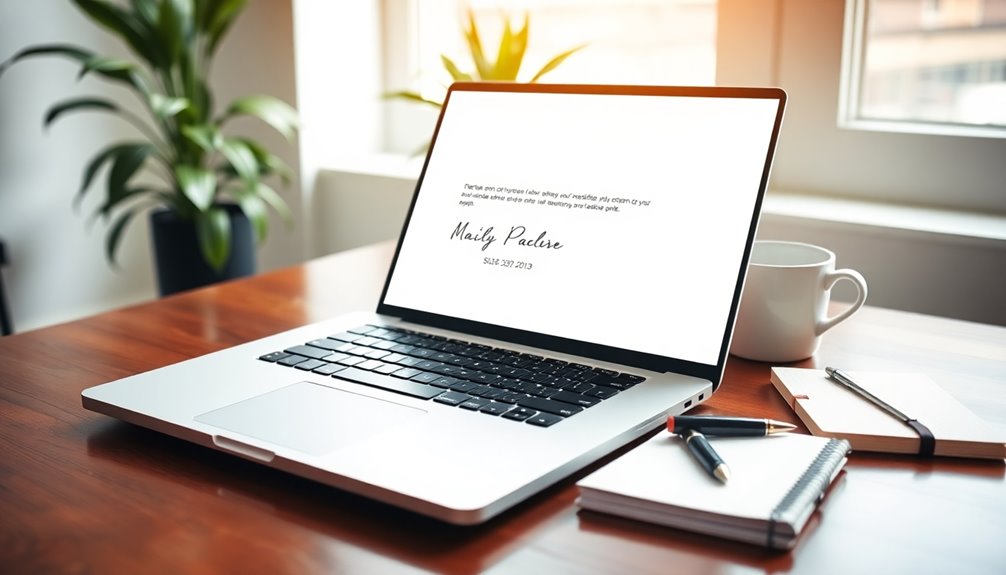
A polished email signature not only showcases professionalism but also serves as a key communication tool. An effective professional email signature includes your full name, job title, and Company Name, guaranteeing recipients can quickly identify who you are. Don't forget to add your contact information, like phone numbers and email addresses, to make it easy for people to reach you.
Incorporating links to your professional social media profiles, such as LinkedIn, can enhance your credibility. This allows recipients to learn more about your background and expertise. A well-structured email signature should feature a clear hierarchy of information, making it easy for recipients to spot essential details at a glance.
Consistent use of branding elements, like your company logo and colors, reinforces brand recognition and professionalism. Aim to keep your email signature concise—ideally no more than 5-6 lines. This not only guarantees visual appeal but also prevents overwhelming the reader. By focusing on these elements, you'll create an email signature that reflects your professionalism and strengthens your communication.
Common Mistakes to Avoid
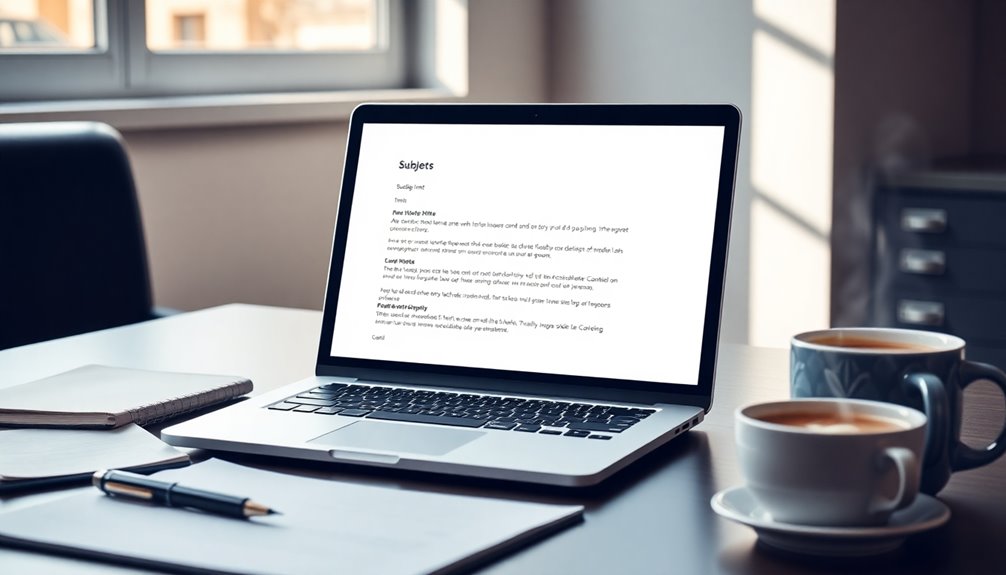
Clarity is essential in email communication, and avoiding common mistakes can make a significant difference in how your messages are received. Here are some pitfalls to watch out for:
- Using vague subject lines can leave your email overlooked and ignored.
- Failing to personalize your messages may make recipients feel undervalued.
- Overly lengthy emails can lose your reader's attention and reduce engagement.
To maintain professionalism, always proofread before hitting send. Spelling and grammar errors can undermine your credibility. Aim for concise communication; keeping your emails short and focused helps keep the tone light and engaging. Always include a clear call to action, so recipients know what you expect from them. If you're using email templates, make sure to personalize them to reflect your unique voice and relationship with the recipient.
Additionally, demonstrating strong communication skills can significantly enhance the effectiveness of your emails, fostering better relationships with your recipients. Finally, don't forget to thank them for their time. A simple line like "I appreciate you taking the time to read this" can go a long way. By being mindful of these common mistakes, you'll enhance your email etiquette and strengthen your professional image. Best regards!
Frequently Asked Questions
What Is the Best Professional Reply to an Email?
When crafting a professional email reply, start with a respectful greeting, using the recipient's name for a personal touch. Reference their original message to provide context, ensuring clarity and continuity. Keep your response concise, focusing on key points to respect their time. End with a polite closing and a clear call to action, encouraging them to respond or take the next steps. Finally, proofread your email to eliminate any errors.
How Do I Make My Email Look Professional?
To make your email look professional, start with a clear subject line that summarizes your message. Address the recipient by name and maintain a polite, formal tone throughout. Use proper grammar and structure your email with paragraphs or bullet points for clarity. Keep it concise and to the point, and don't forget to include a professional signature with your name, job title, and contact information. This way, you'll project credibility and professionalism.
How Do You End an Email Like a Pro?
Did you know that 93% of communication is non-verbal? Ending your email professionally is essential. To wrap up your email like a pro, use a courteous closing phrase like "Best regards" or "Sincerely." Reinforce your main points and express gratitude for the recipient's time. Don't forget to include your full name, job title, and contact info in your signature. Personalizing your closing can also create a stronger connection.
What Is the Most Professional Looking Email?
To craft the most professional-looking email, start with a clear subject line that summarizes your message. Address the recipient with a respectful greeting, like "Dear [Recipient’s Name]." Keep your content concise, using short paragraphs or bullet points for easy reading. Maintain a polite tone throughout, even if the topic is challenging. Finally, wrap up with a professional signature that includes your name, title, and contact information to enhance your credibility.
Conclusion
Crafting the perfect email response is like tuning a fine instrument; it requires attention to detail and a sense of harmony. By mastering subject lines, maintaining a professional tone, and structuring your emails effectively, you'll hit all the right notes. Remember to respond promptly and include a polished signature to leave a lasting impression. Avoid common pitfalls, and you'll not only look like a pro but also compose emails that resonate well with your recipients.
